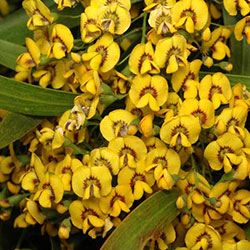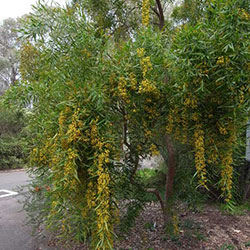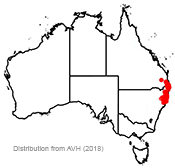Daviesia arborea
 |
 |
Golden Pea, Bitterleaf Pea
 Endemic to Australia, Daviesia arborea, commonly known as Golden Pea tree, or Bitterleaf Pea, belongs to the Fabaceae family. Daviesia arborea is found along the east coast of Australia, occurring in south-east Queensland and north-eastern New South Wales, extending from the Bunya Mountains, north-west of Brisbane, southward to near Comboyne. It is found in Eucalyptus-dominant wet sclerophyll forests on coastal hills or mountain slopes between 50 to 1100 metres above sea level, growing on fine textured soils.
Endemic to Australia, Daviesia arborea, commonly known as Golden Pea tree, or Bitterleaf Pea, belongs to the Fabaceae family. Daviesia arborea is found along the east coast of Australia, occurring in south-east Queensland and north-eastern New South Wales, extending from the Bunya Mountains, north-west of Brisbane, southward to near Comboyne. It is found in Eucalyptus-dominant wet sclerophyll forests on coastal hills or mountain slopes between 50 to 1100 metres above sea level, growing on fine textured soils.
Daviesia arborea grows into a large shrub or tree, between 6 and 14 metres tall. Its "leaves" (actually modified leaf stalks known as phyllodes) are linear, 4 to 20 cm long and 4 to 12 mm wide with parallel venation, and a tapered apex and base. The tree bark is corky.
Daviesia arborea is desirable in any native garden because of its beautiful drooping branches or pendulous habit, with yellow flowers with faint red markings, producing a sweet honey scent. Flowering occurs in spring between September and October, attracting bees and various insects. The fruiting period is from December to January.
Seed can be collected in summer when temperatures are high. Ensure seed pods are collected slightly before maturity as seeds will be released explosively from the plant when mature. When propagating, it's important to note that the seed coat is hard and will require pre-treatment before germination. Alleviating physical dormancy can be achieved by several different methods including scarification, soaking in hot water for 24 hours or dry heat shock (drying in an oven at 80 to 120° C for an hour).
Daviesia arborea is best grown in semi shade conditions on well drained soils. Avoid planting in areas where the morning sun in winter occurs, especially in areas prone to frosts, as the sun can 'burn' the leaves and hinder the tree's development. Daviesia arborea requires very little maintenance with low nutrients needed, although adding native fertilisers can encourage flower yield. It doesn't require pruning and is not prone to diseases. However, it is best to regularly water as it can be susceptible to heat stress in harsh summer conditions. To avoid heat stress and water loss, use mulch to retain soil moisture and avoid planting in full sun.
Overall, Daviesia arborea is an excellent Australian native to grow as its beautiful drooping branches and clusters of sweet-smelling yellow flowers will make a fine addition to your native garden. Its low maintenance requirements will surely be desirable for any gardener.Sebastian Schrimpf, Volunteer Botanical Training Program Participant 2018
Name meaning: Daviesia arboreaDaviesia - in honour of Welsh botanist, Rev. Hugh Davies (1739–1821) arborea - from the Latin word meaning tree, or tree-like |
References:
Cochrane, A. (2007) Seed Notes for Western Australia. No. 15 Hard seed — Chorizema, Daviesia, Gastrolobium and Gompholobium. Perth Branch of the Wildflower Society of Western Australia (Inc.). Available at https://www.dpaw.wa.gov.au/images/documents/about/science/pubs/seednotes/sn15_hardseed.pdf [Accessed 30 May 2018].
Crisp, M. D., Cayzer, L., Chandler, G. T., & Cook, L. G. (2017) A monograph of Daviesia (Mirbelieae, Faboideae, Fabaceae). Phytotaxa 300(1): 1–308.
Harden, G. J. (1990) Flora of New South Wales Vol. 3. UNSW Press.
Hunstone, J. (2018) Horticulturist, Australian National Botanic Gardens. Personal Communication.
Williams, K. A. W. (1979) Native plants of Queensland Vol. 1. Ipswich, Queensland.
Wrigley J, W. & Fagg, M (2007) Australian Native Plants. Reed New Holland, Sydney, Australia.
![An Australian Government Initiative [logo]](/images/austgovt_brown_90px.gif)

